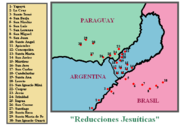
Guarani War
Encyclopedia

Spain
Spain , officially the Kingdom of Spain languages]] under the European Charter for Regional or Minority Languages. In each of these, Spain's official name is as follows:;;;;;;), is a country and member state of the European Union located in southwestern Europe on the Iberian Peninsula...
-Portuguese
Portugal
Portugal , officially the Portuguese Republic is a country situated in southwestern Europe on the Iberian Peninsula. Portugal is the westernmost country of Europe, and is bordered by the Atlantic Ocean to the West and South and by Spain to the North and East. The Atlantic archipelagos of the...
forces. It was a result of the Treaty of Madrid
Treaty of Madrid (1750)
The Spanish–Portuguese treaty of 1750 or Treaty of Madrid was a document signed by Ferdinand VI of Spain and John V of Portugal on January 13, 1750, concerning their empires and status of their territories in what is now Brazil....
, which set a line of demarcation between Spanish and Portuguese colonial territory in South America
South America
South America is a continent situated in the Western Hemisphere, mostly in the Southern Hemisphere, with a relatively small portion in the Northern Hemisphere. The continent is also considered a subcontinent of the Americas. It is bordered on the west by the Pacific Ocean and on the north and east...
.
The boundary drawn up between the two nations was the Uruguay River
Uruguay River
The Uruguay River is a river in South America. It flows from north to south and makes boundary with Brazil, Argentina, and Uruguay, separating some of the Argentine provinces of the Mesopotamia from the other two countries...
, with Portugal possessing the land east of the river. The seven Jesuit missions east of the Uruguay River, known as the Misiones Orientales
Misiones Orientales
The Misiones Orientales or Sete Povos das Missões are a historic region in South America, in present-day Rio Grande do Sul, the southernmost State of Brazil....
, were to be dismantled and relocated on the Spanish western side of the river. The seven missions were called San Miguel
São Miguel das Missões
São Miguel das Missões is a Unesco World Heritage site located in the small town of São Miguel das Missões in the northwestern region of Rio Grande do Sul, a state in southern Brazil. It is also known as São Miguel Arcanjo and by its Spanish language name San Miguel...
, Santos Angeles
Santo Ângelo
Santo Ângelo is a city located in northwestern Rio Grande do Sul state, Brazil. City population is about 76,304 inhabitants and the total area of the municipality is about 677 km²...
, San Lorenzo Martir, San Nicolas, San Juan Bautista, San Luis Gonzaga, and San Francisco de Borja
São Borja
São Borja is a city in the Brazilian state of Rio Grande do Sul. São Borja is the oldest municipality in the Brazilian state of Rio Grande do Sul and was founded in 1682 by the Jesuits as the first of the Seven Points of the Missions, and named São Francisco de Borja, in honor of Saint Francis...
.
In 1754 the Jesuits surrendered control of the missions, but the Guarani led by Sepé Tiaraju
Sepé Tiaraju
Sepé Tiaraju was an indigenous Guarani leader born in the Jesuit reduction mission of São Luiz Gonzaga and who died on February 7, 1756, in the municipality of São Gabriel, in the present-day state of Rio Grande do Sul, Brazil....
, refused to comply with the order to relocate. Efforts by the Spanish army in 1754 to forcefully remove the Guarani from the missions failed. In February 1756 a combined force of 3,000 Spanish and Portuguese soldiers attacked the settlements. It resulted in the death of 1,511 Guarani, while the Europeans suffered only 3 deaths. In the aftermath of the battle, the joint Spanish-Portuguese army occupied the seven missions.
Eventually Spain and Portugal annulled the 1750 treaty in the Treaty of El Pardo
Treaty of El Pardo (1761)
The Treaty of El Pardo was signed on February 12, 1761 between representatives of the Spanish Empire and the Portuguese Empire.Based on the terms of the treaty, all aspects of the Treaty of Madrid were repealed...
, with Spain regaining control over the seven missions and its surrounding territory.
The 1986 film The Mission shows these events.

